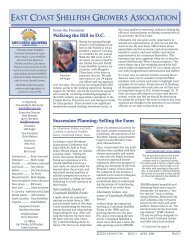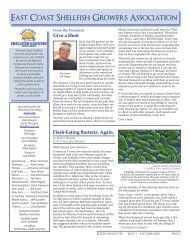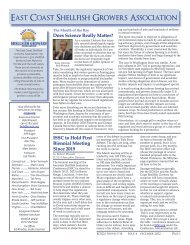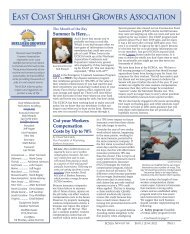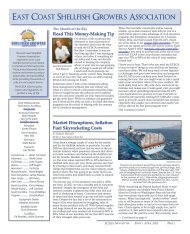ECSGA October 2022 Newsletter
This issue contains articles on social license for aquaculture, cultural benefits and social impacts of shellfish aquaculture, how best management practices differ from laws and regulations, mortality rates in floating gear vs. bottom gear, the story of how the Oceanfarmr (formerly known as SmartOysters) app came to be, and the difference between gross sales and net profit,
This issue contains articles on social license for aquaculture, cultural benefits and social impacts of shellfish aquaculture, how best management practices differ from laws and regulations, mortality rates in floating gear vs. bottom gear, the story of how the Oceanfarmr (formerly known as SmartOysters) app came to be, and the difference between gross sales and net profit,
You also want an ePaper? Increase the reach of your titles
YUMPU automatically turns print PDFs into web optimized ePapers that Google loves.
Cultural Benefits and the Social Impact<br />
of Shellfish Aquaculture<br />
By Adriane Michaelis, Social Scientist, ECS in support of NOAA’s<br />
Southeast Fisheries Science Center<br />
As shellfish growers and industry<br />
supporters, most readers are<br />
probably aware of the impact<br />
the industry has on local water,<br />
on communities and beyond.<br />
But have you thought about all<br />
of the impacts?<br />
Through the discussion of<br />
ecosystem services (the benefits<br />
obtained from an ecosystem)<br />
you’re likely familiar with<br />
benefits provided by shellfish,<br />
ranging from the food product (a<br />
provisioning service), to contributing<br />
to water clarity (a regulating<br />
service), to providing habitat<br />
for other species (a supporting<br />
service). This is just a sample of<br />
the benefits provided by farmed<br />
shellfish, representing three categories<br />
of ecosystem services.<br />
MICHAEL LUDVIGSEN<br />
Aquaculture can continue a family<br />
heritage of working with oysters,<br />
as illustrated in this image of family<br />
members in front of a shell pile.<br />
(Photo submitted as part of the<br />
research project highlighted and<br />
used with permission.)<br />
The fourth category, cultural<br />
services, has not received as<br />
much attention, but these are<br />
important and may offer a better<br />
means of connecting to a wider<br />
audience. In their most basic<br />
definition, cultural ecosystem<br />
services are the “nonmaterial<br />
benefits of an ecosystem.” A<br />
more translatable definition<br />
describes cultural services as the<br />
contributions ecosystems make<br />
to human well-being through<br />
the identities they frame, the<br />
experiences they enable, and the<br />
capabilities they equip (Fish et<br />
al., 2016).<br />
All of these benefits are created<br />
through the interaction of cultural<br />
practices (farming oysters,<br />
for example) in an environmental<br />
space (like the flats of Wellfleet).<br />
This expanded definition<br />
has shaped research to detail<br />
the cultural ecosystem services<br />
associated with bivalve shellfish<br />
(Table 1; Michaelis et al., 2021).<br />
This list of benefits was created<br />
through on-the-farm interviews<br />
with more than 200 shellfish<br />
growers and others connected<br />
to the industry along the East<br />
Coast and Gulf Coast. The<br />
benefits showcase what shellfish<br />
farming—and in some cases,<br />
also a wild shellfishery—can<br />
provide for an individual and a<br />
community, beyond the positive<br />
environmental impacts.<br />
Bivalves shape a variety of<br />
identities: for some, continuing<br />
a family heritage of working the<br />
water; for others, creating an<br />
opportunity for a new legacy.<br />
In some cases, shellfish farming<br />
identities were specifically linked<br />
to greater reliability and security<br />
than other work on the water,<br />
particularly if wild harvest was<br />
restricted or unpredictable. For<br />
others, the heritage is not necessarily<br />
working the water, but<br />
perhaps includes family traditions<br />
roasting oysters, shucking<br />
oysters or simply eating oysters.<br />
Farming oysters offers an opportunity<br />
to connect to those<br />
positive memories.<br />
Table 1. Cultural ecosystem services enabled through work with shellfish are<br />
presented as associated identities, experiences and capabilities. (Adapted<br />
from Michaelis et al., 2021).<br />
Community identities are also<br />
formed by a sense of place tied<br />
to shellfish. This is evident in<br />
the naming of towns like Shell<br />
Pile, Bivalve, and Oyster, which<br />
signify long relationships with<br />
shellfisheries and a sense of<br />
place that shellfish farming can<br />
contribute to. It does not take<br />
a town named after shellfish,<br />
however, to associate its identity<br />
or notoriety with bivalves—think<br />
Apalachicola or Cherrystone.<br />
In many communities, shellfishcentered<br />
identities are celebrated<br />
through oyster festivals, shucking<br />
contests and other events.<br />
Not only do these celebrations<br />
provide shared experiences—a<br />
benefit noted in interviews with<br />
growers—but they also contribute<br />
to local economies. Shellfish<br />
farms provide local, healthy and<br />
sustainable seafood and can further<br />
contribute to tourism-driven<br />
economies through shellfish<br />
trails, farm tours and oyster bars.<br />
This list of benefits represents<br />
more than just a research pursuit,<br />
and more than just reasons<br />
shellfish farmers like their job.<br />
It also represents another way<br />
— Continued on page 14<br />
<strong>ECSGA</strong> <strong>Newsletter</strong> Issue 3 <strong>October</strong> <strong>2022</strong> Page 3




